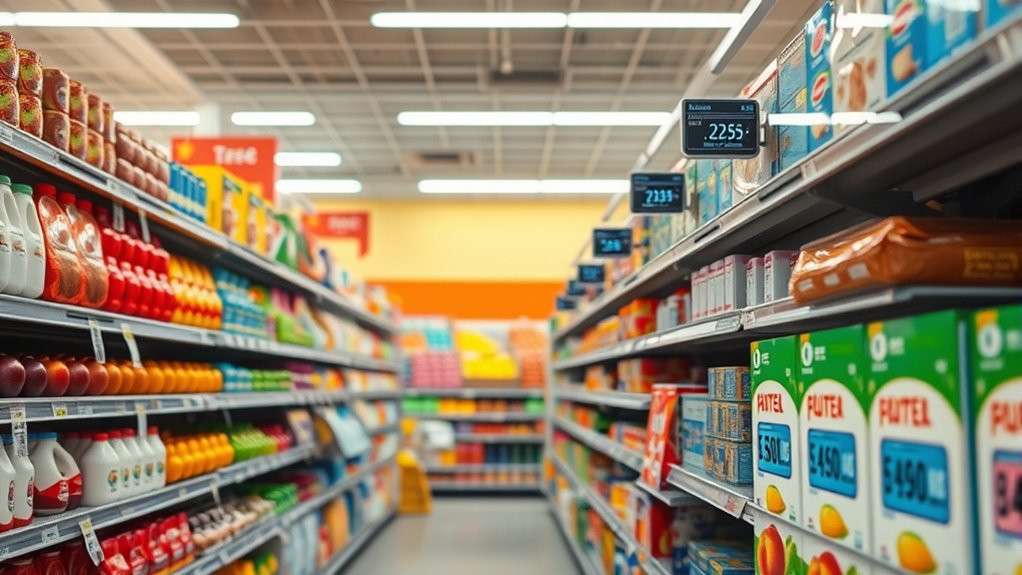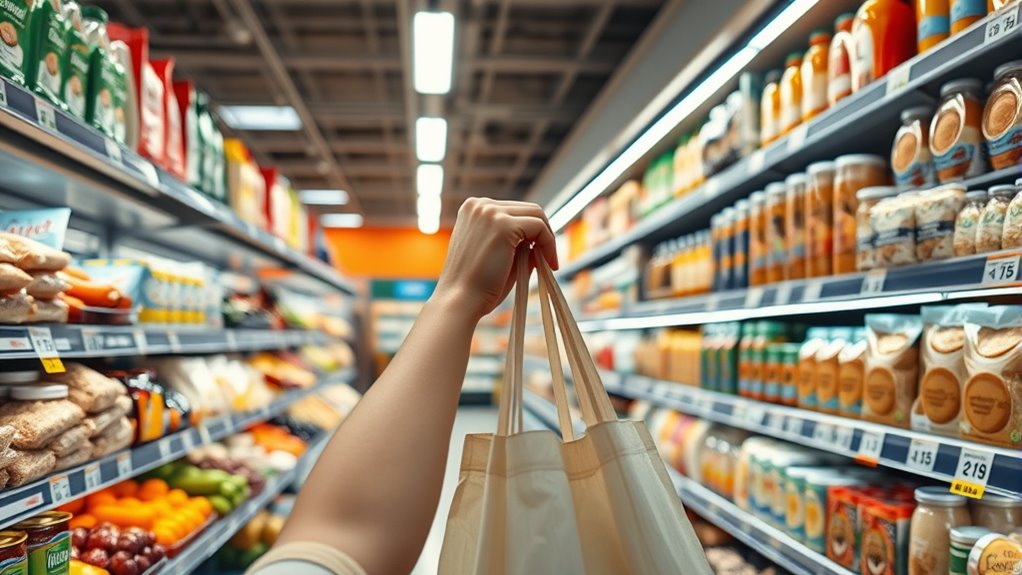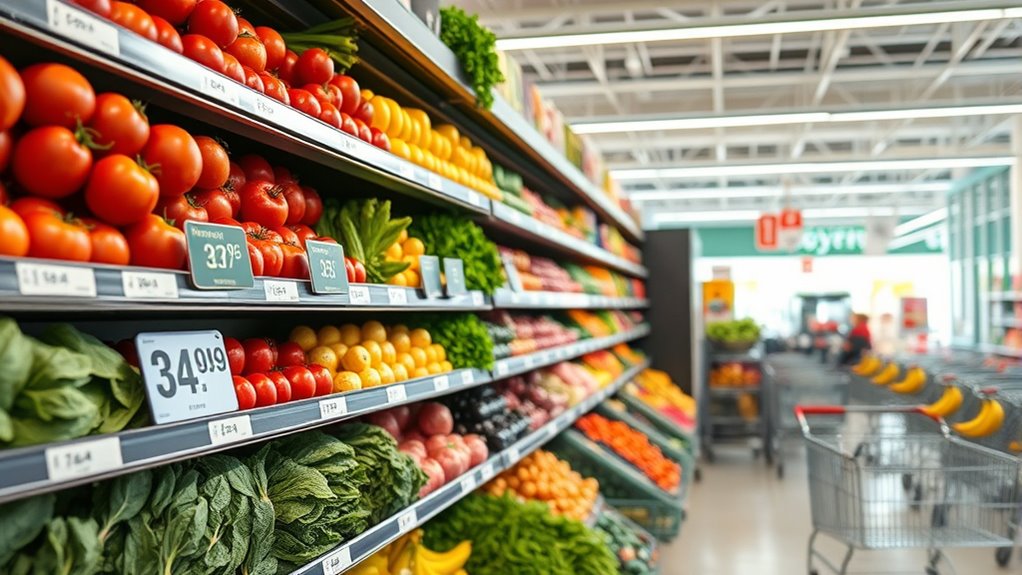In 2025, grocery prices are rising due to supply chain issues, regional differences, and environmental factors like weather. You’ll notice costs vary by area, with some regions seeing much higher hikes. To manage these increasing expenses, focus on meal planning, shopping sales, buying seasonal or store-brand items, and reducing waste. Staying smart about your shopping can help you stretch your food budget, and if you keep exploring, you’ll find more tips to stay ahead.
Key Takeaways
- Overall food inflation remains moderate at around 2.0%, but regional variations cause significant differences in grocery costs.
- Transportation, supply chain disruptions, and environmental factors heavily influence regional food prices and supply stability.
- Prices for staples like eggs, meat, and dairy are rising faster, impacting household budgets and shopping habits.
- Strategic planning, bulk buying, and choosing seasonal, store-brand items help consumers manage rising grocery expenses.
- Staying adaptable with meal planning and price comparison tools is essential to navigate fluctuating food costs in 2025.
Overview of Grocery Price Trends in 2025

Grocery prices in 2025 have experienced moderate growth, with overall inflation slowing compared to previous years. This trend reflects efforts like farmers’ subsidies, which help stabilize prices by supporting local producers and reducing volatility. Additionally, food waste reduction initiatives contribute to more efficient supply chains, preventing surplus and lowering costs. While some staples like ground beef and eggs saw sharp increases, overall food inflation has remained relatively controlled at around 2.0% year-over-year in the first half of 2025. These measures, combined with improved supply chain management, have helped curb rapid price hikes. Furthermore, advancements in supply chain technology are optimizing inventory and distribution processes, further mitigating unexpected cost surges. However, persistent factors such as weather disruptions and global market pressures continue to influence food costs, creating a complex landscape for consumers and policymakers alike.
Regional Differences in Food Cost Increases

You’ll notice that grocery price increases vary considerably across regions, driven by local supply chain issues and transportation costs. Economic factors like regional employment and income levels also influence how much prices rise. Understanding these differences helps you see why some areas face much higher food expenses than others. Additionally, the availability of fresh produce, such as fresh lemon juice, can impact local food prices due to spoilage rates and storage challenges.
Regional Price Variability
Regional differences in food cost increases are striking, with some states experiencing nearly double the inflation rates seen elsewhere. These regional disparities cause significant price variation, affecting local grocery bills differently. For example, Pennsylvania’s inflation rates are considerably higher than Colorado’s, leading to a notable gap in household food expenses. Metro areas like Orlando, Florida, see grocery price hikes averaging 6.5%, more than twice the increase in cities such as Richmond, Virginia. This variability stems from factors like regional supply chain costs, transportation expenses, and economic conditions. As a result, your grocery bill can vary by hundreds of dollars annually depending on where you live. Understanding regional disparities helps you anticipate how local economic dynamics influence food prices and plan your household budget accordingly. Additionally, these variations are often linked to regional supply chain costs, which can fluctuate based on local infrastructure and logistical factors.
Transportation and Supply Chains
Transportation costs and supply chain efficiency play a crucial role in determining regional food price differences. Logistics innovation, such as automation and real-time tracking, helps reduce transportation costs and streamline deliveries, but disparities still exist across regions. Areas with better infrastructure and access to efficient logistics tend to experience lower food prices, while regions facing logistical challenges face higher costs. Supply chain disruptions, whether from weather, labor shortages, or global market shifts, can cause delays and increased expenses, raising prices locally. Regional differences in transportation costs directly impact grocery prices, especially for perishable goods. Improving logistics and supply chain resilience can help stabilize costs, but current regional disparities highlight how transportation and supply chain factors continue to influence food affordability across the country. Efficient logistics systems are essential for minimizing regional price gaps and ensuring consistent food access nationwide.
Economic Factors Impacting Costs
Economic factors such as local supply and demand, labor costs, and regional policies directly influence the variation in grocery price increases across different areas. In regions where food waste is higher or shopping habits favor bulk buying, prices can rise faster due to supply chain inefficiencies. Conversely, areas with better waste management and streamlined shopping habits often see slower price increases. Transportation costs and regional regulations also play a role, making some states more vulnerable to inflation spikes. These disparities mean your grocery bills can differ markedly depending on your location. Understanding these regional economic factors helps you anticipate price changes and adjust your shopping strategies accordingly, whether it’s reducing food waste or choosing stores that better manage costs. Additionally, store hours can impact the availability of sales and discounts, influencing how and when you shop to maximize savings.
Key Factors Influencing Food Prices This Year

You’ll notice that supply chain disruptions and weather patterns have played a major role in shaping food prices this year. When supply chains falter or weather turns unfavorable, prices for staples like produce and meats tend to spike. These factors continue to drive fluctuations and contribute to the overall rising costs you see in grocery stores. Additionally, the ongoing impact of climate change has further intensified unpredictable weather events, exacerbating supply issues and price volatility.
Supply Chain Disruptions
Supply chain disruptions have played a significant role in shaping food prices in 2025. These disruptions strain supply chain resilience, making it harder to get products to stores on time. Transportation delays, labor shortages, and port congestion have increased costs and reduced inventory availability. As a result, grocery stores struggle to maintain steady stock levels, leading to higher prices for consumers. You may notice shortages of certain staples or price spikes, especially for perishable items. Effective inventory management becomes essential during these times, helping retailers minimize waste and control costs. When supply chains are unpredictable, you pay more for the same goods. Improving resilience and streamlining logistics are key strategies to mitigate future disruptions and stabilize food prices. Additionally, hackathons can serve as innovative platforms to develop solutions that enhance supply chain efficiency and reduce vulnerabilities.
Weather and Climate Effects
Weather and climate patterns have had a significant impact on food prices in 2025, disrupting production cycles and supply chains. Climate change has intensified weather fluctuations, leading to unpredictable droughts, floods, and storms that damage crops and delay harvests. These extreme events push up costs for farmers, who face higher expenses for irrigation, pest control, and recovery efforts. As a result, prices for staples like lettuce, tomatoes, and onions fluctuate sharply throughout the year. Regions affected by adverse weather see even steeper increases, contributing to inflation disparities across states. If these weather patterns persist, they’ll likely continue to drive food price volatility, making it harder for consumers to plan and afford their groceries. Climate resilience efforts are increasingly crucial for safeguarding agricultural productivity against ongoing climate challenges. Addressing climate change is vital to stabilizing food costs long-term.
Category-Specific Price Movements

How have prices for specific food categories shifted throughout 2025? You’ll notice significant price fluctuation across different categories, shaping consumer perception of affordability. Fresh vegetables, for example, initially dropped early in the year but then rose for four consecutive months, ending about 2.9% higher than August 2024. Fruits and vegetables overall saw a slight deflation early on but later experienced increases. Meat and dairy, especially ground beef and eggs, faced above-average inflation—up by double digits—making them more costly. Sugar and sweets also saw notable increases, driven by candy and gum. These category-specific movements influence how you view food costs, highlighting the uneven nature of inflation and the importance of monitoring price trends within each category to manage your grocery budget effectively. Additionally, understanding category-specific price movements can help consumers identify which food groups are experiencing the most volatility and plan their shopping accordingly.
How Rising Grocery Costs Affect Consumers

As grocery prices rise steadily in 2025, consumers are feeling the financial strain more acutely than before. You may notice your consumer behavior shifting—perhaps you’re buying fewer luxury items or switching to store brands to save money. Shopping habits are changing as well; you might be making more frequent trips to discount stores or planning meals more carefully to reduce waste. Rising costs for staples like eggs, ground beef, and coffee hit household budgets hard, forcing you to adjust spending and prioritize essentials. The increased grocery bills can lead to stress and even debt, especially if regional price hikes are significant. Overall, these rising costs influence how you shop, what you buy, and how you manage your household food expenses.
Strategies to Manage Food Expenses

To effectively manage food expenses in 2025, you need to adopt strategic shopping habits that maximize savings. One key approach is meal planning, which helps you buy only what you need, reducing impulse purchases and food waste. Planning weekly menus allows you to focus on discounted items and seasonal produce, cutting costs. Be mindful of food waste by storing leftovers properly and utilizing perishable ingredients promptly. Bulk buying staples like rice, pasta, and canned goods can lower unit prices, but avoid over-purchasing perishables you won’t consume quickly. Comparing prices across stores and using coupons or loyalty programs also helps. Staying organized with your shopping list and sticking to it prevent unnecessary expenses, ensuring your food budget stretches further despite rising prices. Additionally, exploring best grocery savings strategies can further optimize your spending and help you adapt to fluctuating food costs.
The Role of Supply Chains and Weather Patterns

Supply chains and weather patterns play a significant role in shaping grocery prices in 2025. Disruptions in supply chain resilience, such as transportation delays or shortages, directly increase costs that consumers bear. When supply chains are vulnerable, even minor issues can cause ripple effects, driving prices higher. Weather forecast accuracy also impacts prices—unpredictable weather, like droughts or storms, reduces crop yields and raises prices for staples like vegetables and grains. Improved weather predictions help farmers prepare and minimize losses, stabilizing supply and costs. Conversely, inaccurate forecasts can lead to unexpected shortages and price spikes. Overall, the interplay between resilient supply chains and precise weather forecasting determines how much consumers pay at the grocery store, especially amid ongoing climate variability.
Future Outlook for Food Prices

Despite ongoing inflationary pressures, the outlook for food prices in 2025 suggests a continued but moderate increase overall. You’ll likely see some relief but should remain cautious. Here are three key points to contemplate:
Food prices are expected to rise moderately in 2025, so stay cautious and plan wisely.
- Expect overall food prices to rise about 3.0%, with some staples like sweets and meat still pushing costs higher.
- Fresh vegetable prices will stay relatively steady, but seasonal fluctuations may impact your meal planning.
- Reducing food waste and planning meals carefully can help you manage costs as prices remain unpredictable.
Focusing on smarter meal planning and minimizing waste can make a real difference in your grocery budget, especially with uneven price pressures across categories and regions. Staying proactive is your best strategy in this environment.
Tips for Budget-Friendly Grocery Shopping

With grocery prices rising steadily in 2025, it’s more important than ever to adopt budget-friendly shopping strategies. Start by planning your grocery shopping trips with a detailed list to avoid impulse buys. Use budget tips like comparing prices across stores, shopping sales, and buying in bulk for staples. Focus on seasonal produce, which tends to be cheaper and fresher. Consider generic or store brands—they often offer quality at lower prices. Keep an eye out for coupons and digital deals, and avoid shopping when hungry, which can lead to unnecessary purchases. Additionally, cooking at home more often helps you control costs and reduce waste. By applying these grocery shopping tips, you can stretch your dollar further and better manage rising food costs in 2025.
Frequently Asked Questions
How Do Grocery Prices in 2025 Compare to Previous Years?
You’ll notice that grocery prices in 2025 have increased over previous years, driven by inflation trends and fluctuations in the food supply. Overall, prices have risen about 2.0% in the first half of 2025, with some staples like eggs and ground beef rising markedly. Compared to past years, this marks a slower inflation rate, but regional differences and supply chain issues still cause notable price variability across food categories.
Which Regions Experienced the Highest Food Inflation in 2025?
Ever wonder where the food inflation hotspots are? You’ll find that regional disparities hit hardest in states like Pennsylvania, where grocery prices surged nearly twice as much as in Colorado. These areas experience the highest food inflation due to local supply chain issues and economic factors. Such disparities highlight how your grocery bills can vary dramatically depending on where you live, making some regions more vulnerable to rising food costs than others.
What Foods Contributed Most to Overall Grocery Price Increases?
You’ll notice that staple foods like ground beef (+12.8%), eggs (+10.9%), and coffee (+20.9%) contributed most to the price surge in 2025. These items saw significant increases, pushing overall grocery prices higher. Their rising costs heavily impact household budgets, especially since staples are essential for daily meals. The inflation in these foods reflects supply chain issues, weather impacts, and global market dynamics, making them key drivers of grocery price increases this year.
How Are Consumers Coping With Rising Grocery Costs?
You’re likely coping with rising grocery costs by adjusting your habits, like meal planning to reduce waste and sticking to a shopping list. Discount shopping becomes essential, whether through store brands, sales, or buying in bulk. These strategies help stretch your budget and manage expenses, especially for staples like eggs, meat, and coffee, which have seen significant price hikes. Staying flexible and strategic keeps your grocery bills more manageable.
Will Grocery Prices Stabilize or Continue Rising in the Coming Months?
You’re probably wondering if grocery prices will finally take a breather or keep teasing your wallet. Well, expect some price fluctuations—like a roller coaster with a few dips, thanks to supply chain tweaks and weather whims. To survive, sharpen your shopping strategies: buy in bulk, cling to sales, and avoid those trendy, overpriced organic kale. While a little stability might peek through, be ready for more surprises ahead.
Conclusion
As grocery prices continue to climb in 2025, your shopping habits might need to change more than you think. Will upcoming supply chain disruptions and unpredictable weather push costs even higher? Staying informed and adaptable could be your best defense. The choices you make today might determine how comfortably you navigate rising food expenses tomorrow. Are you ready to uncover the strategies that could keep your food budget afloat? The answers lie just ahead—don’t miss out.










